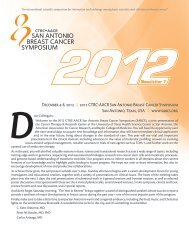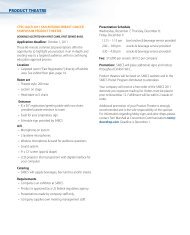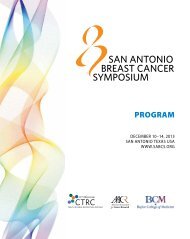Abstract Book - PDF - San Antonio Breast Cancer Symposium
Abstract Book - PDF - San Antonio Breast Cancer Symposium
Abstract Book - PDF - San Antonio Breast Cancer Symposium
Create successful ePaper yourself
Turn your PDF publications into a flip-book with our unique Google optimized e-Paper software.
December 4-8, 2012 <strong>Abstract</strong>s: Poster Session 2<br />
P2-14-05<br />
A phase II study of combined fulvestrant and RAD001<br />
(everolimus) in metastatic estrogen receptor (ER) positive breast<br />
cancer after aromatase inhibitor (AI) failure.<br />
Croley JJ, Black EP, Romond E, Chambers M, Waynick S, Slone<br />
S, Waynick C, Stevens M, Weiss HL, Massarweh SA. University of<br />
Kentucky and Markey <strong>Cancer</strong> Center, Lexington, KY<br />
Background: Fulvestrant is used to treat women with metastatic<br />
ER-positive breast cancer after AI failure, but has a short duration<br />
of benefit. Pi3K/mTOR signaling has been implicated in preclinical<br />
models of fulvestrant resistance and recent trials suggest that<br />
everolimus, an oral inhibitor of mTOR, can overcome resistance to<br />
other forms of endocrine therapy. We hypothesized that everolimus<br />
may delay resistance to fulvestrant and prolong time to progression<br />
(TTP).<br />
Methods: We designed a phase II clinical trial of combined fulvestrant<br />
and everolimus in postmenopausal women with ER-positive breast<br />
cancer who relapsed or experienced metastatic disease progression<br />
within 6 months of AI use. Fulvestrant was given at 500 mg<br />
IM on day1, 250 mg d14, 250 mg d28, and monthly thereafter.<br />
Everolimus was given at 10 mg po daily. Patients were required to<br />
have measurable or evaluable disease with preserved performance<br />
status and adequate organ function. Primary endpoint is TTP, and<br />
secondary endpoints are safety, response rate, clinical benefit rate,<br />
and biomarker analysis. A sample size of 40 patients was calculated<br />
to meet a median TTP of 7.0 vs. 3.7 months for fulvestrant alone<br />
as reported in the EFECT trial. Patients were followed monthly for<br />
clinical and toxicity assessment and imaging was obtained every 2<br />
months. Tumor blocks were collected when available and biopsies<br />
were offered if disease was accessible.<br />
Results: To date, 30 patients enrolled on study with a median age of 56<br />
years (range 39-85). Most common metastatic disease sites were bone<br />
in 26 patients (87%), liver in 19 (63%), and lung in 16 (53%). Prior<br />
therapy included tamoxifen in 21 patients (70%), and chemotherapy<br />
in 20 (67%), of those 17 were in the adjuvant/neoadjuvant setting.<br />
6 patients (20%) received more than one AI. 2 patients were ruled<br />
ineligible immediately after enrollment and starting study treatment,<br />
one because of a creatinine level outside the reference range and<br />
one because of the need for palliative radiation. Of the remaining<br />
28 patients, 18 discontinued therapy because of disease progression,<br />
3 because of toxicity, 2 upon patient request, and 1 because of<br />
unrelated intercurrent illness, with 4 patients currently on therapy.<br />
Most common adverse events reported were mucositis in 13 patients<br />
(43%) and rash in 11 (36%). Most common laboratory abnormalities<br />
were elevated ALT/AST in 18 patients (60%), elevated cholesterol in<br />
13 (43%), and hypokalemia in 13 (43%). The majority of toxicities<br />
were grade I/II. Most common grade III toxicities, regardless of<br />
attribution, were infection requiring hospitalization in 3 patients<br />
(10%), hypokalemia in 3 (10%) and mucositis in 2 (7.4%). There was<br />
one grade 4 toxicity reported-hypokalemia. Overall, treatment was<br />
reasonably tolerated and toxicities manageable. Efficacy findings,<br />
including the primary endpoint of TTP, will be analyzed and presented<br />
at the meeting.<br />
Conclusions: Combined everolimus with fulvestrant is feasible and<br />
has manageable toxicities in this cohort of women with metastatic<br />
ER-positive breast cancer. Detailed efficacy analysis along with<br />
updated toxicity data will be presented at the meeting.<br />
P2-14-06<br />
A phase II trial of low dose estradiol in postmenopausal women<br />
with advanced breast cancer and acquired resistance to an<br />
aromatase inhibitor.<br />
Howell SJ, Seif MW, Armstrong AC, Cope J, Wilson G, Welch RS,<br />
Misra V, Ryder D, Blowers E, Palmieri C, Wardley AM. University of<br />
Manchester, United Kingdom; The Christie NHS Foundation Trust,<br />
Manchester, United Kingdom; Imperial College, London, United<br />
Kingdom<br />
Background High dose estrogen (HDE) is an effective but toxic<br />
treatment for postmenopausal women with advanced breast<br />
cancer (ABC). In vitro, prolonged periods of estrogen deprivation<br />
(ED) sensitises cancers to the inhibitory effects of estrogen. We<br />
hypothesised that the profound ED seen with third generation<br />
aromatase inhibitor (AI) would sensitise cancers to LDE which would<br />
be better tolerated.<br />
Methods Single arm phase II study in postmenopausal women<br />
with measurable ER+ ABC and demonstrated clinical benefit (CB)<br />
with a third generation AI. Treatment: estradiol valerate 2mg daily.<br />
Primary endpoint: CB rate (CBR) was correlated with baseline and<br />
dynamic LH/FSH levels and on-treatment estradiol levels. Secondary<br />
endpoints included TTF, PFS, toxicity and QoL. If LDE was effective,<br />
retreatment with the AI on which the cancer had progressed prior<br />
to study entry was offered on progression. If LDE was ineffective<br />
HDE was offered.<br />
Results 21/50 patients were recruited before early closure due to slow<br />
accrual. 19 were assessable for efficacy and toxicity (1 ineligible; 1<br />
no LDE). CBR was 5/19 (26%; 95%CI 9.1%,51.2%). Median TTF<br />
2.8months (range 0.5-29.8). CBR durations were 11.1, 16.8, 17.3*,<br />
19.8, 29.8 months (*censored). 4 stopped treatment early due to<br />
toxicity (G4 hypercalcaemia/ G2 vaginal bleeding (VB) plus G4<br />
hyponatraemia/ G2 mucositis/ G2 headaches) 1 with SD at 3 months<br />
and 3 before response assessment. Other common toxicities were all<br />
G1/2 and mainly limitted to nausea (8/19), breast pain (7/19) and<br />
tumour flare (7/19). VB occurred in 8/11 without prior hysterectomy.<br />
Baseline LH correlated with CBR by logistic regression (p=0.01). Of<br />
3 retreated with the same AI post LDE; 1 had PR, 1 SD ≥6months<br />
and 1 PD. One woman received HDE after failure of LDE and<br />
achieved a PR.<br />
Conclusion LDE is an effective and largely well tolerated treatment<br />
in women with acquired resistance to AI. VB is common without<br />
prior hysterectomy. Rechallenge with the same AI post LDE seems<br />
effective and may offer an extra line of endocrine therapy. This should<br />
be tested in future trials.<br />
P2-14-07<br />
Evaluation of Aromatase Inhibitor failure and total healthcare<br />
expenditures among post-menopausal women with metastatic<br />
ER+/HER2- breast cancer in the US<br />
Namjoshi M, Landsman-Blumberg P, Thomson E, Chu BC. Novartis<br />
Pharmaceuticals Corporation, East Hanover, NJ; Thomson Reuters,<br />
Washington, DC<br />
Aromatase Inhibitors (AIs) have replaced tamoxifen as first-line<br />
therapy for post-menopausal women with metastatic, ER+ breast<br />
cancer (BC). However, little information is available on the realworld<br />
use of AIs. This retrospective administrative claims study<br />
compared healthcare expenditures of post-menopausal women with<br />
metastatic ER+/HER2- BC treated with AIs and experiencing 0 or<br />
≥ 1 AI failures (AIF).<br />
Women ≥ 55 years of age newly diagnosed with stage IV BC (index)<br />
were identified in the 2006-2010 Thomson Reuters MarketScan<br />
www.aacrjournals.org 281s<br />
<strong>Cancer</strong> Res; 72(24 Suppl.) December 15, 2012











